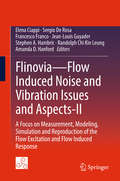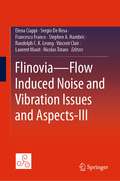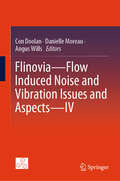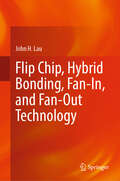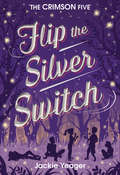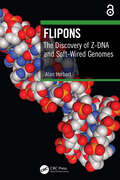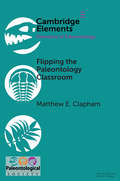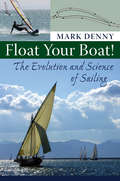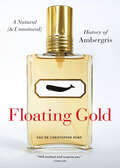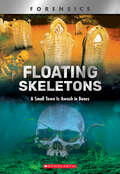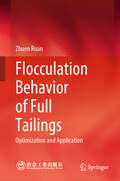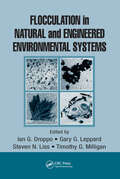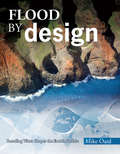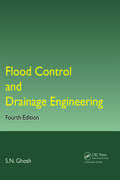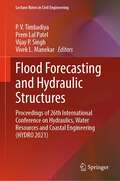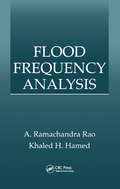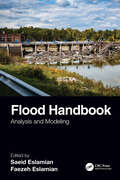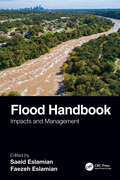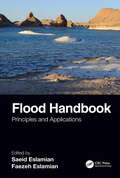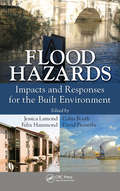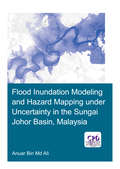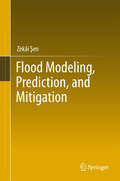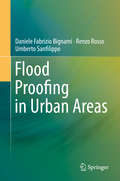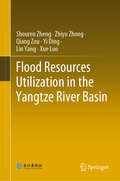- Table View
- List View
Flinovia—Flow Induced Noise and Vibration Issues and Aspects-II: A Focus on Measurement, Modeling, Simulation and Reproduction of the Flow Excitation and Flow Induced Response
by Jean-Louis Guyader Stephen A. Hambric Elena Ciappi Sergio De Rosa Francesco Franco Randolph Chi Kin Leung Amanda D. HanfordThis is the proceedings of the Second International Workshop on Flow Induced Noise and Vibration (FLINOVIA), which was held in Penn State, USA, in April 2016. The authors’ backgrounds represent a mix of academia, government, and industry, and several papers include applications to important problems for underwater vehicles, aerospace structures and commercial transportation. The book offers a valuable reference guide for all those working in the area of flow-induced vibration and noise.Flow induced vibration and noise (FIVN) remains a critical research topic. Even after over 50 years of intensive research, accurate and cost-effective FIVN simulation and measurement techniques remain elusive. This book gathers the latest research from some of the most prominent experts in the field.The book describes methods for characterizing wall pressure fluctuations, including subsonic and supersonic turbulent boundary layer flows over smooth and rough surfaces using computational methods like Large Eddy Simulation; for inferring wall pressure fluctuations using inverse techniques based on panel vibrations or holographic pressure sensor arrays; for calculating the resulting structural vibrations and radiated sound using traditional finite element methods, as well as advanced methods like Energy Finite Elements; for using scaling approaches to universally collapse flow-excited vibration and noise spectra; and for computing time histories of structural response, including alternating stresses.
Flinovia—Flow Induced Noise and Vibration Issues and Aspects-III
by Stephen A. Hambric Elena Ciappi Sergio De Rosa Francesco Franco Randolph C. K. Leung Vincent Clair Laurent Maxit Nicolas TotaroThis volume gathers the latest advances and innovations in the field of flow-induced vibration and noise, as presented by leading international researchers at the 3rd International Symposium on Flow Induced Noise and Vibration Issues and Aspects (FLINOVIA), which was held in Lyon, France, in September 2019. It explores topics such as turbulent boundary layer-induced vibration and noise, tonal noise, noise due to ingested turbulence, fluid-structure interaction problems, and noise control techniques. The authors’ backgrounds represent a mix of academia, government, and industry, and several papers include applications to important problems for underwater vehicles, aerospace structures and commercial transportation. The book offers a valuable reference guide for all those interested in measurement, modelling, simulation and reproduction of the flow excitation and flow induced structural response.
Flinovia—Flow Induced Noise and Vibration Issues and Aspects—IV
by Danielle Moreau Con Doolan Angus WillsThis book gathers the latest advances and innovations in the field of flow-induced vibration and noise, as presented by leading international researchers at the 4th International Symposium on Flow-Induced Noise and Vibration Issues and Aspects (FLINOVIA), which was held in Sydney, Australia, in May 2023. It explores topics such as turbulent boundary layer-induced vibration and noise, noise due to ingested turbulence, rotor noise, fluid-structure interaction problems, innovative measurement methods, and noise control techniques. The authors’ backgrounds represent a mix of academia, government, and industry, and several papers include applications to important problems for underwater vehicles, aerospace applications, and commercial transportation. The book offers a valuable reference guide for all those interested in measurement, modelling, simulation, and reproduction of the flow excitation and flow-induced structural response.
Flip Chip, Hybrid Bonding, Fan-In, and Fan-Out Technology
by John H. LauThis book focuses on the design, materials, process, fabrication, and reliability of flip chip, hybrid bonding, fan-in, and fan-out technology. Both principles and engineering practice have been addressed, with more weight placed on engineering practice. This is achieved by providing in-depth study on a number of major topics such as wafer bumping, flip chip assembly, underfill and reliability, chip-to-wafer, wafer-to-wafer, Cu-Cu hybrid bonding, WLCSP, 6-side molded WLCSP, FOWLP such as hybrid substrates with PID, ABF, and ultra-large organic interposer, the communications between chiplets and heterogeneous integration packaging, and on-board optics, near-package optics, and co-packaged optics.The book benefits researchers, engineers, and graduate students in the fields of electrical engineering, mechanical engineering, materials sciences, industry engineering, etc.
Flip the Silver Switch (The Crimson Five #2)
by Jackie YeagerThe Crimson Five are headed to the Piedmont Global Championships in Quebec, where they'll compete against the best inventor teams in the world. Kia and her New York teammates are excited to share a new amazing invention — but they're blind-sided with another task to solve, with just two weeks to do it!As the team struggles with a lack of creativity, rumors leave The Crimson Five questioning everything about each other. Kia knows she and her team must come together like never before in order to win a coveted spot on the Swirl and Spark Creativity Tour, but tragedy threatens to derail all that they've built.The Crimson Five are together again.Because sometimes it takes a whole team to help you see things clearly.
Flipons: The Discovery of Z-DNA and Soft-Wired Genomes
by Alan HerbertAlan Herbert has played a leading part in discovering the biological roles for a high-energy form of DNA twisted to the left rather than to the right. Both Z-DNA and the Z-RNA sensing proteins are critical for protecting hosts against both viruses and cancers. The proteins also play critical roles in the programmed cell death of aging cells. Other types of flipons exist and alter the readout of transcripts from the genome, encoding genetic information by their shape rather than by their sequence. Many of these flipons are within repeat elements that were previously considered to be just genomic junk. Instead these genetic elements increase the adaptability of cells by flipping DNA conformation. By acting as digital switches, the different flipon types can alter cellular responses without any change to their sequence or any damage to DNA. These highly dynamic structures enable the rapid evolution of multicellular organisms. The junk DNA in repeats also encode peptide patches that enable the assembly of cellular machines. The intransitive logic involved enhances the chance of an individual surviving a constantly changing environment.Key Features Causes us to rethink how information is encoded in the genome Changes our understanding of how our genome evolved and how we protect ourselves against viruses and cancers while sparing normal cells Shows that high energy forms of DNA, such as left-handed DNA do exist inside the cell Accessible to those in academia and the general public, and speaks to the next generation, encouraging them to find their own path in scientific discovery The Open Access version of this book, available at http://www.taylorfrancis.com, has been made available under a Creative Commons Attribution-Non-Commercial-No Derivative License (CC-BY-NC-ND) 4.0 license.
Flipping the Paleontology Classroom: Benefits, Challenges, and Strategies (Elements of Paleontology)
by Matthew E. ClaphamLecturing has been a staple of university pedagogy, but a shift is ongoing because of evidence that active engagement with content helps strengthen learning and build more advanced skills. The flipped classroom, which delivers content to students outside of the class meeting, is one approach to maximize time for active learning. The fundamental benefit of a flipped class is that students learn more, but ensuring student preparation and engagement can be challenging. Evaluation policies can provide incentives to guide student effort. Flipping a class requires an initial time commitment, but the workload associated with evaluating student work during the course can be mitigated. The personal interactions from active learning are extremely rewarding for students and instructors, especially when class sizes are small and suitable room layouts are available. Overall, flipping a course doesn't require special training, just a willingness to experiment, reflect, and adjust.
Float Your Boat!: The Evolution and Science of Sailing
by Mark DennyAn estimated 4.1 million people in the United States participate in recreational sailing. Yet the large library of sailing literature leaves many of them high and dry. On one side are technical guides for America’s Cup boat-builders; on the other, simplistic books for weekend sailors with little interest in science. In Float Your Boat! professional and amateur boaters alike will find intelligent and understandable answers to such questions as: What were the key innovations that made sailboats more efficient? How do you increase the speed of a boat? How do sailboats travel into the wind? Why are so many explanations of sailing so wrong? Sailing enthusiast and physicist Mark Denny first traces the evolution of the sailing craft, from prehistoric coracles made of animal skins and antlers to the sailboat’s reinvention as a pleasure craft during the Industrial Revolution. He then identifies specific sailing phenomena—how wind drives modern Bermuda sloops, how torque determines stability, why hull speed exists—and provides the key physics principles behind them. Whether you are an inquisitive landlubber who has never set foot in a boat, a casual weekend sailor, or an old salt who lives for the sea, Float Your Boat! is an accessible guide to the physics of sailing.
Floating Gold: A Natural (& Unnatural) History of Ambergris
by Christopher KempA fascinating natural history of an incredibly curious substance. “Preternaturally hardened whale dung” is not the first image that comes to mind when we think of perfume, otherwise a symbol of glamour and allure. But the key ingredient that makes the sophisticated scent linger on the skin is precisely this bizarre digestive by-product—ambergris. Despite being one of the world’s most expensive substances (its value is nearly that of gold and has at times in history been triple it), ambergris is also one of the world’s least known. But with this unusual and highly alluring book, Christopher Kemp promises to change that by uncovering the unique history of ambergris. A rare secretion produced only by sperm whales, which have a fondness for squid but an inability to digest their beaks, ambergris is expelled at sea and floats on ocean currents for years, slowly transforming, before it sometimes washes ashore looking like a nondescript waxy pebble. It can appear almost anywhere but is found so rarely, it might as well appear nowhere. Kemp’s journey begins with an encounter on a New Zealand beach with a giant lump of faux ambergris—determined after much excitement to nothing more exotic than lard—that inspires a comprehensive quest to seek out ambergris and its story. He takes us from the wild, rocky New Zealand coastline to Stewart Island, a remote, windswept island in the southern seas, to Boston and Cape Cod, and back again. Along the way, he tracks down the secretive collectors and traders who populate the clandestine modern-day ambergris trade.Floating Gold is an entertaining and lively history that covers not only these precious gray lumps and those who covet them, but presents a highly informative account of the natural history of whales, squid, ocean ecology, and even a history of the perfume industry. Kemp’s obsessive curiosity is infectious, and eager readers will feel as though they have stumbled upon a precious bounty of this intriguing substance.
Floating Skeletons: A Small Town Is Awash in Bones (XBooks: Forensics)
by Danielle DenegaWho will put the dead back to rest?It's the Great Flood of 1993, and much of the Midwestern U.S. is covered with water. But tiny Hardin, Missouri, is covered with something much, much worse: dead bodies.High-interest topics, real stories, engaging design, and astonishing photos are the building blocks of the XBooks, a new series of books designed to engage and motivate reluctant and enthusiastic readers alike. How can DNA help a convicted person prove their innocence? How did a burglar steal from a store without leaving any fingerprints? Why was the tiny town in Hardin, Missouri, awash with skeletons after a huge flood? With topics based in science, these action-packed books will help students unlock the power and pleasure of reading... and always ask for more!
Floating and Sinking: Student Investigations
by National Science Resources CenterNIMAC-sourced textbook
Flocculation Behavior of Full Tailings: Optimization and Application
by Zhuen RuanThis book focuses on the flocculation behavior of full tailings, analyzes the influence of multiple factors such as flow field shear on flocculation behavior, constructs a dynamic model of full tailings flocculation behavior, simulates and studies the flocculation behavior of full tailings in the feedwells of deep cone thickener, and optimizes the feeding and internal flocculation parameters. This book can be read by researchers, designers, and engineering technicians related to backfill mining, as well as by teachers and students of mining majors in universities.
Flocculation in Natural and Engineered Environmental Systems
by Ian G. Droppo Gary G. Leppard Steven N. Liss Timothy G. MilliganWhile new developments in genomics, nanotechnology, sampling, and modelling permit increasingly revealing investigation into flocculation structure and processes, there is still a fundamental lack of knowledge related to many aspects of this phenomenon. Presented by a prominent team of international experts, this text takes a unique perspective and melds together the natural and engineering fields of science as they relate to this central phenomenon. In doing so, the authors present the full range of sampling, handling, analytical, and interpretive options for operational management of natural or engineered system, providing comprehensive coverage that meets the needs of researchers, practitioners and students.
Flood By Design
by Michael OardThere are features on the earth's surface that science cannot explain with theories of changes over millions or even billions of years by the geographic processes that we see occurring commonly today. However, when you explore the evidence from a biblical worldview, the geological features marking the planet's surface make sense given the worldview catastrophic flood described in the book of Genesis. Join author Mike Oard as he explores what is termed as "the retreating stage of the flood" - the seven month-period when the waters receded and the landscapes which are familiar to us were formed by a myriad of processes like uplifts and sinking, erosion, and more, which answer important questions regarding: Unusual dispersals of rocks over hundred of miles How quickly mountains and valleys were carved Emergence of continents and the formation of ocean basins Percussions marks shaped by vast and violently moving water Why very gradual erosion and deposits of soil cannot explain surface formations The study of geomorphology and what it can reveal Flood by Design takes you into a fascinating aspect of the Genesis flood you may never have considered. Examine unusual rock formations and evidence that only the biblical flood model can fully explain. Filled with many photographs and easy-to-understand illustrations and charts, the books is a powerful source of research and answers for high school students and beyond.
Flood Control and Drainage Engineering
by S.N. GhoshPrimarily written as course material on flood control and drainage engineering for advanced students of civil engineering, this new fourth edition is again thoroughly revised. It accommodates recent developments in remote sensing, information technology and GIS technology. New added material deals with flood management due to Tsunami waves, floodin
Flood Forecasting and Hydraulic Structures: Proceedings of 26th International Conference on Hydraulics, Water Resources and Coastal Engineering (HYDRO 2021) (Lecture Notes in Civil Engineering #340)
by Vijay P. Singh P. V. Timbadiya Prem Lal Patel Vivek L. ManekarThis book comprises the proceedings of the 26th International Conference on Hydraulics, Water Resources and Coastal Engineering (HYDRO 2021) focusing on broad spectrum of emerging opportunities and challenges in the field of flood forecasting and hydraulic structures. It covers a range of topics, including, but not limited to, early warning system, urban flood modelling and management, dam hazard classification, river training and protection works, structural and non-structural measures for flood mitigation, assessment and development of flood vulnerability, hazard and risk maps rehabilitation of old dams, streamflow turbines, canal operation and related structure, operation and management of dams including their instrumentation etc.Presenting recent advances in the form of illustrations, tables, and text, it offers readers insights for their own research. In addition, the book addresses fundamental concepts and studies in the field of flood forecasting and hydraulic structures, making it a valuable resource for both beginners and researchers wanting to further their understanding of hydraulics, water resources and coastal engineering.
Flood Frequency Analysis
by A. Ramachandra Rao Khaled H. HamedAfter five decades, the field of Statistical Hydrology continues to evolve and remains a very active area of investigation. Researchers continue to examine various distributions, methods of estimation of parameters, and problems related to regionalization. However, much of this research appears in journals and reports and usually in a form not easi
Flood Handbook: Analysis and Modeling
by Saeid Eslamian and Faezeh EslamianFloods are difficult to prevent but can be managed in order to reduce their environmental, social, cultural, and economic impacts. Flooding poses a serious threat to life and property, and therefore it’s very important that flood risks be taken into account during any planning process. This handbook presents different aspects of flooding in the context of a changing climate and across various geographical locations. Written by experts from around the world, it examines flooding in various climates and landscapes, taking into account environmental, ecological, hydrological, and geomorphic factors, and considers urban, agricultural, rangeland, forest, coastal, and desert areas. Features: Presents the main principles and applications of the science of floods, including engineering and technology, natural science, and sociological implications. Considers floods in urban, agricultural, rangeland, forest, coastal, and desert areas. Covers flood control structures as well as preparedness and response methods. Written in a global context, by contributors from around the world.
Flood Handbook: Impacts and Management
by Saeid Eslamian and Faezeh EslamianFloods are difficult to prevent but can be managed in order to reduce their environmental, social, cultural, and economic impacts. Flooding poses a serious threat to life and property, and therefore it’s very important that flood risks be taken into account during any planning process. This handbook presents different aspects of flooding in the context of a changing climate and across various geographical locations. Written by experts from around the world, it examines flooding in various climates and landscapes, taking into account environmental, ecological, hydrological, and geomorphic factors, and considers urban, agriculture, rangeland, forest, coastal, and desert areas. Features Presents the main principles and applications of the science of floods, including engineering and technology, natural science, as well as sociological implications. Examines flooding in various climates and diverse landscapes, taking into account environmental, ecological, hydrological, and geomorphic factors. Considers floods in urban, agriculture, rangeland, forest, coastal, and desert areas Covers flood control structures as well as preparedness and response methods. Written in a global context, by contributors from around the world.
Flood Handbook: Principles and Applications
by Saeid Eslamian and Faezeh EslamianFloods are difficult to prevent but can be managed in order to reduce their environmental, social, cultural, and economic impacts. Flooding poses a serious threat to life and property, and therefore it’s very important that flood risks be taken into account during any planning process. This handbook presents different aspects of flooding in the context of a changing climate and across various geographical locations. Written by experts from around the world, it examines flooding in various climates and landscapes, taking into account environmental, ecological, hydrological, and geomorphic factors, and considers urban, agriculture, rangeland, forest, coastal, and desert areas. Features Presents the main principles and applications of the science of floods, including engineering and technology, natural science, as well as sociological implications. Examines flooding in various climates and diverse landscapes, taking into account environmental, ecological, hydrological, and geomorphic factors. Considers floods in urban, agriculture, rangeland, forest, coastal, and desert areas Covers flood control structures as well as preparedness and response methods. Written in a global context, by contributors from around the world.
Flood Hazards: Impacts and Responses for the Built Environment
by Jessica Lamond David Proverbs Colin Booth Felix HammondA 360-degree view of the response to flood riskAs major flooding events around the world show, the impact of flooding on the built environment can cause widespread chaos. These flood events form part of a wider pattern of increasing flood frequency coupled with increased vulnerability of the built environment to flood hazard. Flood risk can unite o
Flood Inundation Modeling and Hazard Mapping under Uncertainty in the Sungai Johor Basin, Malaysia (IHE Delft PhD Thesis Series)
by Anuar Bin AliFlooding can have devastating impacts on people’s livelihood, economy and the environment. An important instrument in flood management is floodplain maps, which assist land planners and local authorities in identifying flood-prone areas, and provide useful information for rescue and relief agencies for their operations. Developing floodplain maps often involves flood inundation modeling. This typically requires precipitation and stream flow data, topographic information, building a hydraulic model and calibration of its parameters. Often however, floodplain maps are built on a single model outcome without an explicit consideration of all the sources of uncertainty in the modeling process. The research presented in this thesis addresses the uncertainty in flood inundation modeling, which may arise from input data and hydraulic modeling approach. The study area is the Sungai Johor basin in Johor, Malaysia, an agriculture-dominated area. The present study analyses the modelling uncertainties arising from estimations of design flow, terrain data sets, geometric description in hydraulic models and different modeling approaches, and develops recommendations for practitioners. Explicit account for uncertainties and studying their impact in flood inundation mapping allow for more informed and effective decision making.
Flood Modeling, Prediction and Mitigation
by Zekâi ŞenThis book draws on the author’s professional experience and expertise in humid and arid regions to familiarize readers with the basic scientific philosophy and methods regarding floods and their impacts on human life and property. The basis of each model, algorithm and calculation methodology is presented, together with logical and analytical strategies. Global warming and climate change trends are addressed, while flood risk assessments, vulnerability, preventive and mitigation procedures are explained systematically, helping readers apply them in a rational and effective manner. Lastly, real-world project applications are highlighted in each section, ensuring readers grasp not only the theoretical aspects but also their concrete implementation.
Flood Proofing in Urban Areas
by Daniele Fabrizio Bignami Renzo Rosso Umberto SanfilippoFlood control in urban areas can be feasibly and cost-effectively enhanced by implementing flood proofing approaches to risk reduction in the context of environmental and land-use planning and management. Indeed, flood proofing makes it possible to improve, integrate and in some cases even replace traditional measures for flood control, reducing the vulnerability and increasing the resilience of buildings and infrastructures.This book begins by reviewing the physics of stability and instability of both human beings and buildings under flood conditions, together with criteria and models (both conventional and innovative) for assessing flood strains. In turn, it presents a range of flood proofing concepts and techniques, together with a complete and updated classification of related methods and devices. This provides a user-friendly tool to help identify appropriate solutions to real-world problems for each specific risk scenario.In particular, the book focuses on temporary flood proofing techniques, given their ability to deliver effective performance at low costs. Lastly, it features an overview of norms, guidelines and laboratory recommendations that are currently being adopted in various countries with regard to flood proofing devices and testing procedures.The purpose of this book is essentially to encourage authorities, stakeholders, technicians and end users to successfully develop flood proofing solutions that can reduce flood risk in a pragmatic manner. In addition, the authors hope to inspire researchers, manufacturers and designers (engineers, architects, urban planners and urban managers) to pursue further advances in this key sector of public and private safety in urban areas.
Flood Resources Utilization in the Yangtze River Basin
by Yi Ding Lin Yang Shouren Zheng Zhiyu Zhong Qiang Zou Xue LuoThis book is highly informative and carefully presented, providing scientific insights into the flood resources utilization in the Yangtze River Basin both for scholars and decision-makers. The book is for the purpose of analyzing the potential utilization of flood resources in the Yangtze River Basin and exploring effective ways to put forward the countermeasures against the risks. Major objectives of this book include: (1) revealing the characteristics of the inflow and the sediment variation in the upper reaches of the Yangtze River, quantitatively evaluating the potential utilization of the flood resources in the Yangtze River and demonstrating the feasibility of its utilization in the Basin; (2) proposing the necessity and feasibility of utilizing the flood resources by the Three Gorges Project; (3) shedding new light on the characteristics of the flood resources, presenting different methods of flood resources utilization in different regions over the Basin and raising the overall risk-optimized strategies of the flood resources utilization in the Yangtze River; (4) analyzing the risk of flood resources utilization for the Three Gorges Project regarding flood control, sediment, ecology, etc., and putting forward the risk-optimized countermeasures of flood resources utilization for the Three Gorges Project.
